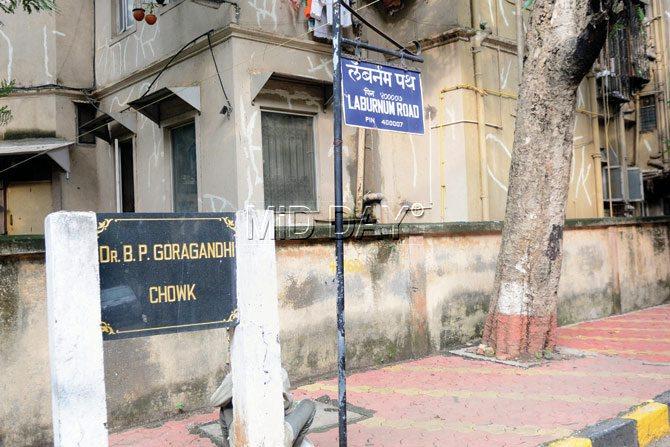I grew up in a home on Ramdas Nayak Marg, walking the paths around its adjacent streets Ramchandra Krishnaji Patkar Marg and Master Vinayak Marg.

Meher Marfatia
 I grew up in a home on Ramdas Nayak Marg, walking the paths around its adjacent streets Ramchandra Krishnaji Patkar Marg and Master Vinayak Marg.
I grew up in a home on Ramdas Nayak Marg, walking the paths around its adjacent streets Ramchandra Krishnaji Patkar Marg and Master Vinayak Marg.
I grew up in a home on Hill Road, walking the paths around its adjacent streets Waterfield Road and Perry Road.
ADVERTISEMENT
But this isn’t a piece on the road renaming game. It’s to cheer the fact that, thanks to flaming gulmohur, laburnum and bougainvillea blooms over Bandra cottage gates, I got interested in observing bits of Bombay named after flora. Tamarind Lane to Laburnum Road, Parel to Cumballa Hill, Babulnath to Bhangwadi, there lie lovely corners of this city that will be forever tree-touched.

Pic/Sameer Markande
It all began with Raja Bhimdev, the 12th century Solanki ruler who set up his capital in Mahikawati (Mahim) and introduced useful fruit-bearing vegetation. Dividing his kingdom into a dozen precincts, or pakhadis, he planted coconut palms to add to forests of babul, or Acacia Arabica, which he found our seven islands covered with.
J Gerson da Cunha’s book, The Origin of Bombay, offers glimpses into Bimbakyan, the Chronicles of Bimb or Bhim. With the king settled groups of Pathare Prabhus, toddy tapper Bhandaris and agricultural communities of Vadvals or Malis. A number of trees from Bhimdev’s reign lent their local nomenclature to where they sprouted. Wadala took after Banyan trees in the area, a corruption of Wadali — ‘wad’ is Marathi for Banyan and ‘ali’ means row. Parel was inspired by the presence of Paralor Padel (Marathi for Trumpet Flower). Umarkhadi derived from fig trees bordering the creek — ‘umbar’ being fruit
of the fig family and khadi, creek.
It was left to Indophile editor Stanley Reed to describe what remains my favourite lane in town and makes me drop with pleasure into slow step each time I savour a stroll through. Said Sir Stanley in a 1920s public address: ‘The palms of Gamdevi have given place to the flat-bordered Hughes Road where the Gold Mohurs and Peltophorums are splendid in May. I rejoice that one of the side roads radiating from it bears the appropriate name of Laburnum Avenue.’
Another charming allusion to Laburnum Road and a pair of parallel alleys comes from Samuel Sheppard’s 1917-published, Bombay Place-names and Street-names: An Excursion into the By-ways of the History of Bombay City... ‘There is an Alexandra Road, one of a little group in Gamdevi which owe their names to the species of tree planted along them by the Improvement Trust: Laburnum Road, Alexandra Road and Cirrus Avenue. Everyone knows a laburnum when he sees one in flower, but the writer will not be alone in making the confession that he has no idea what a Cirrus or an Alexandra look like. The Queen-Mother will, of course, be thought to be the Alexandra referred to, whereas she is presumably godmother to the tree and gives her name only by that indirect method to the road.’
A fistful of flora-fanned localities grace Girgaum — Phanaswadi from gardens spilling with jackfruit trees, Kelewadi from plaintain groves and Pimpalwadi from still standing pipals. A flower grove I’ve always enjoyed explaining is Cumballa Hill: rooted in expansive early acres of ground strewn with pretty kambal, or kamal, lotus blossoms.
Babul plantations at the foot of Malabar Hill, combined with Lord Shiva of the famous temple built here in 1780 even shaped like a Babul tree, gave rise to Babul-nath. Tardeo was christened partly by palm tads flourishing below Cumballa Hill and with a deity (dev) installed, the term Tad-dev came to stay.
Further south, Tamarind Lane owes its origin to a tree near St Thomas’ Cathedral, at the edge of the cotton green, beneath which it was customary to hold auctions. Traders would promise to meet “amli agal” — in front of the tamarind tree — which, the Bombay Gazetteer tells us, fell in November 1846. One among many such once, a solitary tamarind tree today shades the north-east corner of the cathedral compound.
To end on an intoxicating note, in Bhangwadi, the thriving old drama district between Grant Road and Kalbadevi. From dried leaves and small hemp stalks, Cannabis Indica, better known as bhang, mixed with milk, sugar, almonds, cardamom and assorted spices, sold in shops for half an anna to two annas per tola. Just to add to the theatrics, if you will.
 Subscribe today by clicking the link and stay updated with the latest news!" Click here!
Subscribe today by clicking the link and stay updated with the latest news!" Click here!







